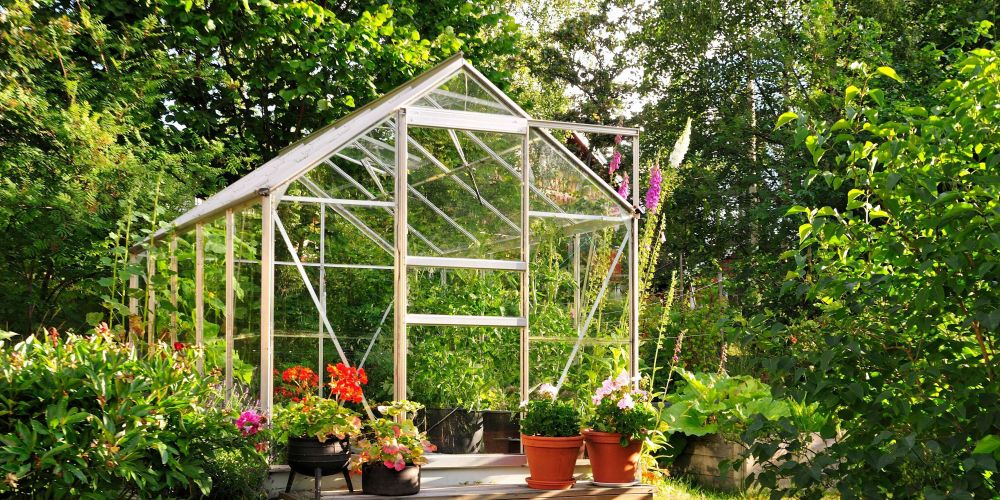When building or upgrading a greenhouse, one of the most important decisions is selecting the right glazing material. The glazing plays a crucial role in controlling temperature, humidity, light transmission, and the overall environment inside the greenhouse.
The two most popular options for greenhouse windows are glass and polycarbonate panels. But which material is the better choice?
There are pros and cons to both glass and polycarbonate for greenhouse glazing. By comparing the key features and performance factors, you can determine which is better suited for your specific needs and climate.
Key Features of Glass Greenhouse Glazing
Glass is a traditional glazing choice that offers some benefits:
- Visibility - Clear glass provides full visibility into the greenhouse. This allows close monitoring of plants.
- Light transmission - Standard glass transmits around 90% of light. This allows adequate light for plant growth.
- Aesthetics - Many homeowners prefer the classic look of glass glazing. It fits in well with backyard designs.
- Lifespan - With proper care, glass can last over 25 years before needing replacement.
However, there are some downsides to using regular glass:
- Fragility - Glass breaks easily when impacted and cannot withstand hail or falling tree limbs.
- Insulation - Glass provides very little thermal insulation. The greenhouse interior will suffer temperature extremes.
- UV protection - Standard glass does not block UV rays that can damage plants.
- Condensation & dripping - Glass encourages condensation buildup and dripping onto plants.
- Weight - Heavy glass sheets are difficult to transport and install.
- Cost - While the initial cost is lower, frequent glass pane replacement drives up long-term costs.
Key Features of Polycarbonate Greenhouse Glazing
Polycarbonate glazing panels offer their own set of advantages:
- Impact resistance - Polycarbonate is extremely impact resistant, protecting against hail, animals, fallen debris, and more.
- Insulation - Multiwall polycarbonate provides excellent insulation to maintain stable interior temperatures.
- UV blocking - Polycarbonate filters 99% of UV rays to prevent sun damage to plants.
- Light diffusion - Panels diffuse light for ideal dispersion without hot spots.
- Condensation control - Polycarbonate resists condensation buildup and allows moisture to sheet off.
- Weight - At just a fraction of the weight of glass, polycarbonate is much easier to work with.
- Lifespan - Properly installed, polycarbonate panels last up to 20 years.
- Safety - Polycarbonate does not shatter like glass, making it safer for greenhouses used by children or schools.
However, some potential drawbacks of polycarbonate glazing include:
- Visibility - While still transparent, polycarbonate panels have slightly less clarity than true glass.
- Light transmission - Around 10% less light is transmitted compared to glass, but still adequate for growing.
- Cost - Polycarbonate can have a higher upfront cost than glass, but pays off long-term.
Polycarbonate vs. Glass Greenhouse Glazing: Which is Better?
Now that we've covered the key attributes of both materials, let's directly compare them in some essential categories. We've summarised some of the key features here:
| Feature | Glass | Polycarbonate |
| Weight | Heavier compared to polycarbonate. | Lighter weight, making it easier to handle and install. |
| Light Transmission | Generally provides high clarity and light transmission. | Varies based on the type, but usually allows good light diffusion. |
| Insulation Properties | Generally lower insulation compared to polycarbonate. | Provides better insulation, especially when multi-walled, helping to maintain a more stable temperature. |
| Durability | Brittle and prone to breaking upon impact. | Impact-resistant and less prone to breakage, making it suitable for areas prone to hail or strong winds. |
| UV Resistance | Blocks some UV radiation, depending on the type of glass. | Generally blocks UV radiation, offering better protection for plants. |
| Installation | Requires careful handling due to its weight and fragility. | Lighter weight makes it easier to handle but may require additional support structures for large panels. |
| Cost |
Typically cheaper than polycarbonate, making it a popular choice for budget-conscious projects. |
Generally more expensive, however does tend to last longer, making a better investment |
| Longevity | Can last for a long time if properly maintained. | Durable, with a longer lifespan and better resistance to weathering. |
| Maintenance | Requires regular cleaning and maintenance. | Low maintenance, often only requiring periodic cleaning. |
| Design Flexibility | Available in various thicknesses and can be cut to custom shapes. | Comes in various forms, including multi-wall panels, offering design flexibility. |
| Environmental Impact | Recyclable, but production may have a higher environmental impact. | Recyclable, with a potentially lower environmental impact in terms of production. |
Durability
When it comes to durability, polycarbonate is the clear winner over glass.
Polycarbonate greenhouse panels are virtually unbreakable. They are 200 times stronger than glass! This makes them extremely resistant to all sorts of impact damage. You'll never have to deal with shattered panels after a hail storm or stray ball again.
Glass, on the other hand, requires constant vigilance. Even a small stone thrown by a lawnmower can result in broken glass panes. Glass becomes more fragile over time as well.
Insulation
Proper insulation is crucial for maintaining ideal temperatures in a greenhouse.
The multiwall structure of polycarbonate captures air to provide exceptional insulation properties. Greenhouses glazed with polycarbonate require far less additional heating and cooling to maintain stable growing temperatures.
Standard glass offers almost no insulation value. Greenhouses relying solely on glass require heavy supplementation with heaters, fans, shade cloths, and other equipment to avoid extreme temperature swings.
Durability
When it comes to durability, polycarbonate is the clear winner over glass.
Polycarbonate greenhouse panels are virtually unbreakable. They are 200 times stronger than glass! This makes them extremely resistant to all sorts of impact damage. You'll never have to deal with shattered panels after a hail storm or stray ball again.
Glass, on the other hand, requires constant vigilance. Even a small stone thrown by a lawnmower can result in broken glass panes. Glass becomes more fragile over time as well.
Light Transmission
Light exposure is another essential consideration for greenhouses.
The glass allows about 90% of light transmission, providing adequate light for most plants.
Polycarbonate transmits around 80-85% of light. The panels also diffuse light and prevent hot spots or glare. The combination of high light transmission and beneficial diffusion makes light penetration ideal for plant growth.
UV Protection
Exposure to harsh UV rays can harm greenhouse plants.
Polycarbonate naturally blocks over 99% of UV radiation. This protects sensitive plants without having to add shading.
Unprotected standard glass does not filter UV rays. Shading or coatings must be added to glass greenhouses to provide necessary UV protection.
Condensation
Condensation and dripping can facilitate mould growth and damage plants.
The smooth surface of polycarbonate allows condensation to effectively run off the panels. This keeps plants and greenhouse structures dry.
Glass tends to accumulate condensation and drip, making the greenhouse environment damp and promoting fungal or mould issues.
Safety
Safety is another important consideration, especially for greenhouses used by schools or families with children.
Polycarbonate panels cannot shatter like glass, making them a much safer glazing option. There's no risk of dangerous shards if damaged.
Broken glass can pose a serious injury hazard for kids or pets in a home greenhouse.
Cost
Looking purely at upfront cost, standard glass is generally cheaper than polycarbonate. However, this doesn't account for the long-term costs.
Frequent glass breakage and replacement can make it the more expensive option over the years. Polycarbonate's durability and longevity keep maintenance costs minimal.
While polycarbonate has a bigger initial investment, it pays for itself over time by being virtually indestructible and reducing heating/cooling costs thanks to its insulation.
Which is Better Overall: Glass or Polycarbonate Greenhouse Glazing?
When all factors are considered, polycarbonate emerges as the best overall choice for most greenhouse glazing applications.
While glass excels in visibility and light transmission, it simply cannot compare to the durability, insulation, and UV resistance of polycarbonate panels. Not to mention polycarbonate's safety and condensation control.
Here's a quick recap of the main benefits of polycarbonate over glass:
- Impact resistant virtually unbreakable
- Insulating maintains stable interior temps
- Blocks UV rays protect plants
- Light diffusion optimal plant growth
- Resists condensation issues
- A safer option, especially for kids
- Long lifespan, lasting decades
For challenging climates or greenhouses that will see heavy use, polycarbonate is the smarter long-term investment.
The only scenario where glass may make sense is a basic backyard greenhouse that will be carefully maintained and protected from the elements.
For serious growers wanting optimal plant health and production, polycarbonate greenhouse glazing is certainly the superior choice.




